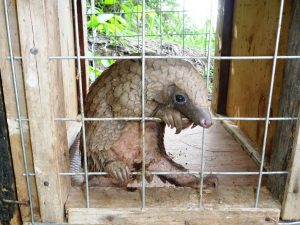
Rescued pangolin before release into IITA forest
Pangolins are extraordinary animals in habits and appearance. Though they look like ant-eaters and armadillos their closest relatives are carnivores, such as cats, dogs and bears. They feed on ants and termites by means of a sticky tongue which is as long as the entire body. It is estimated that one pangolin consumes 70 million a year. Their underparts are hairy but the rest of the body is covered with tough, overlapping scales. When alarmed they roll into a tight ball which may protect against predators but not hunters. There are only eight species in the world – four in Asia and four in Africa – and all are endangered through loss of habitat, hunting for bush meat, and demand for their scales which, though made of keratin – the same substance as our hair and nails – are believed in Asia to have medicinal properties.
The white-bellied or tree pangolin Phataginus tricuspis is found in the IITA Forest Reserve. It measures 60-100cm long from nose to tail but is not often seen as it is nocturnal and sleeps in a burrow or hollow tree during the day. Females give birth to a single young that rides on the mother’s tail for the first few months. This harmless and environmentally useful animal is on the IUCN Red List as VU (Vulnerable).

